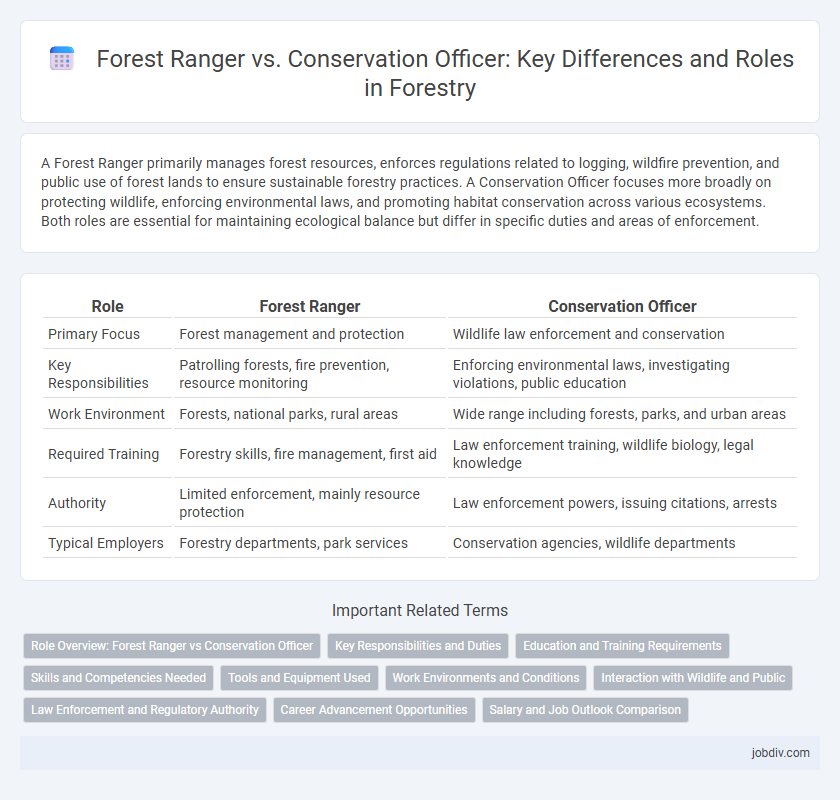A Forest Ranger primarily manages forest resources, enforces regulations related to logging, wildfire prevention, and public use of forest lands to ensure sustainable forestry practices. A Conservation Officer focuses more broadly on protecting wildlife, enforcing environmental laws, and promoting habitat conservation across various ecosystems. Both roles are essential for maintaining ecological balance but differ in specific duties and areas of enforcement.
Table of Comparison
| Role | Forest Ranger | Conservation Officer |
|---|---|---|
| Primary Focus | Forest management and protection | Wildlife law enforcement and conservation |
| Key Responsibilities | Patrolling forests, fire prevention, resource monitoring | Enforcing environmental laws, investigating violations, public education |
| Work Environment | Forests, national parks, rural areas | Wide range including forests, parks, and urban areas |
| Required Training | Forestry skills, fire management, first aid | Law enforcement training, wildlife biology, legal knowledge |
| Authority | Limited enforcement, mainly resource protection | Law enforcement powers, issuing citations, arrests |
| Typical Employers | Forestry departments, park services | Conservation agencies, wildlife departments |
Role Overview: Forest Ranger vs Conservation Officer
Forest Rangers primarily focus on the protection and management of forest resources, including wildfire prevention, reforestation efforts, and monitoring forest health to ensure ecosystem sustainability. Conservation Officers enforce wildlife laws, regulate hunting and fishing activities, and safeguard natural habitats to preserve biodiversity and maintain ecological balance. Both roles require specialized knowledge of environmental laws, but Forest Rangers are more involved in land management while Conservation Officers emphasize wildlife enforcement and public education.
Key Responsibilities and Duties
Forest Rangers primarily focus on managing and protecting forest resources by conducting patrols, monitoring wildlife, enforcing forestry laws, and responding to forest fires. Conservation Officers emphasize enforcing environmental regulations, investigating violations such as illegal hunting or pollution, and educating the public about conservation practices. Both roles require collaboration with government agencies and community stakeholders to ensure sustainable natural resource management.
Education and Training Requirements
Forest Rangers typically require a bachelor's degree in forestry, environmental science, or natural resource management, combined with on-the-job training to develop skills in wildfire control, wildlife monitoring, and public safety enforcement. Conservation Officers often hold degrees in criminal justice, environmental law, or biology and undergo specialized law enforcement training, including firearms proficiency and legal procedures, to enforce environmental regulations effectively. Both roles demand continuous professional development through certifications and field experience to stay updated on evolving conservation techniques and regulatory standards.
Skills and Competencies Needed
Forest Rangers require strong knowledge of forest ecosystems, fire management, and public safety protocols, alongside physical fitness and outdoor survival skills. Conservation Officers must possess expertise in wildlife law enforcement, habitat conservation, and environmental regulations, combined with excellent conflict resolution and investigation abilities. Both roles demand effective communication skills and a commitment to protecting natural resources.
Tools and Equipment Used
Forest rangers primarily rely on GPS devices, chainsaws, and firefighting equipment to manage wildfires and maintain forest trails. Conservation officers utilize advanced surveillance cameras, drones, and communication radios to monitor wildlife populations and enforce environmental regulations. Both roles employ protective gear such as boots, helmets, and high-visibility clothing tailored to their specific field tasks.
Work Environments and Conditions
Forest Rangers primarily work in remote forested areas, often facing rugged terrain, variable weather, and extended outdoor exposure while performing tasks like wildfire suppression and trail maintenance. Conservation Officers operate in more diverse environments, including parks, wildlife reserves, and urban fringes, enforcing laws related to wildlife protection and natural resource management under both field conditions and office settings. Both roles require physical endurance and adaptability, but Forest Rangers typically engage in more physically demanding fieldwork, whereas Conservation Officers balance patrol duties with investigative responsibilities.
Interaction with Wildlife and Public
Forest Rangers primarily monitor forest health and enforce regulations while maintaining safe interactions with wildlife, often educating the public about preserving natural habitats. Conservation Officers focus on enforcing laws related to wildlife protection and natural resource management, frequently handling conflicts between humans and wildlife to ensure public safety and animal conservation. Both roles require strong communication skills to promote awareness and responsible behavior within forest ecosystems.
Law Enforcement and Regulatory Authority
Forest Rangers possess law enforcement authority primarily focused on protecting forest resources, enforcing forestry regulations, and managing wildfire prevention within designated woodland areas. Conservation Officers have broader regulatory powers encompassing wildlife protection, habitat preservation, and enforcement of both environmental and hunting laws across multiple ecosystems. Both roles involve patrolling and monitoring natural environments, but Conservation Officers typically handle a wider scope of environmental legislation beyond forestry-specific rules.
Career Advancement Opportunities
Forest Rangers often advance by gaining specialized skills in wildfire management or wildlife biology, enabling promotions to supervisory or regional management roles. Conservation Officers typically progress through law enforcement certifications and develop expertise in environmental regulations, which opens pathways to senior enforcement or policy advisory positions. Both careers benefit from continuous education and field experience, but Conservation Officers may access broader opportunities in government agencies focused on environmental protection.
Salary and Job Outlook Comparison
Forest rangers earn an average salary range of $40,000 to $60,000 per year, depending on geographic location and experience, while conservation officers typically make between $45,000 and $70,000 annually, reflecting their enforcement responsibilities. Job outlook for forest rangers shows moderate growth at approximately 5% over the next decade, driven by expanding public land management needs; conservation officers face a slightly higher growth rate of 6%, fueled by increased environmental regulation and wildlife protection efforts. Both careers require specialized training and offer opportunities in federal, state, and local agencies, with conservation officers often benefiting from law enforcement benefits and career advancement.
Forest Ranger vs Conservation Officer Infographic

 jobdiv.com
jobdiv.com